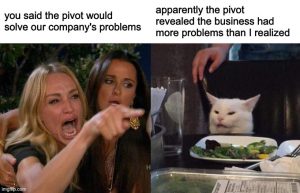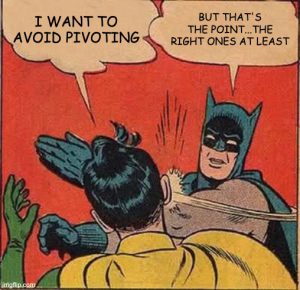Pivots are bread and butter of startup growth, just as much as failure. They are two forces that complement each other and are inseparable. It is through failure (of varying degrees) that a company recognizes a need to pivot. And it is through pivots that failures can be made meaningful as the company leverages learnings from failures to make each pivot worth more than the last. One could go so far as to say that pivots are the lifeblood of innovation.
However, pivots are not always successful. For some companies, it takes multiple iterations to arrive at product-market fit. On the other hand, some pivots are not 180-degree changes in the business. Instead, they are evolutions that involve cutting out the excess and distractions so the company can focus on what is really creating an impact for their customers and the bottomline.
Regardless of what the pivot means to the company, there is a desire shared by any company undergoing such a process to ensure the pivot is worth it. The pivot needs to move the needle of growth, or at the very least, uncover an advantage that could then enable the company to inch closer in its iterations to a stronger relationship with the market and its customers.
We have covered many stories of pivots over the years on Insignia Business Review, like a SaaS media company in Indonesia that turned into the country’s leading social commerce platform for tier-2, tier-3, and rural areas, an MSME financing fintech company that pivoted multiple times to eventually land on a supply chain financing solution which then evolved into including SaaS solutions for MSMEs amidst the pandemic, a digital bookkeeping app that evolved into a platform and marketplace for wholesalers…and many more
In this article, we outline seven steps from these pivots that we have documented over the years:
- Pivots may venture into the unknown but don’t go in blind.
- Pivots are not “Eureka” moments but build-ups over time of resources and market forces aligning towards business evolution.
- Shore up supporters for the pivot across stakeholders.
- Have the right people leading the transition.
- Pivots are tests of organizational resilience, financial discipline, and steadfastness to vision.
- Growth is about building momentum for future pivots.
- Agility and preparation are bread and butter in pivot execution.
(1) Pivots may venture into the unknown but don’t go in blind.
Pivots are ventures into the new, sure, but that doesn’t mean you go into the field blind. Pivots are also not just spur-of-the-moment changes; they require careful study and consideration. If there are, study existing businesses operating with the “new” model. If there are none, learn from your customers/target customers. Get multiple perspectives. Investors can come into play here in providing these perspectives. Some fundamental questions to ask:
(1) Objective of the pivot vis-a-vis current business: What is this pivot ultimately for? A meaningful pivot will solve key deficiencies in the prior business approach; a directionless pivot will just add on to the existing problems.
(2) Meaningfulness of the pivot: Will pursuing this new model or approach make a needle-moving difference with regards to the objective/s in (1)? It is a pitfall to be too headstrong on a certain path without considering others. It is also possible that only certain units of the business need to pivot and not others.
In a podcast published amidst the initial impact of the pandemic on startups in early 2020, Vietnamese investor and entrepreneur Linh Thai shared the importance of taking a wide perspective when considering where and what to pivot:
“You could also look at your entire value chain. Basically everything that you buy and everything that you send out, you know, where does it go, you know, how can you potentially turn it to the supplier, or can you move down and be direct to the consumer, right? So just look at every single tiny aspect of your business and figure out if there’s any way that you can either add on or temporarily pivot or if it would make sense then it would be a full pivot into a different business model.”
(3) Resources relative to the demands of the pivot: Does your team have enough market familiarity or a resource advantage (e.g., networks, capital, existing early adopters, etc.) going into this new approach / segment and achieving (1)?
Linh also talks about the importance of not being carried away by “hot sectors” foregoing familiarty.
“But I would say, be careful, I don’t recommend going into an industry that you’re not familiar with. So don’t pivot into one of these hot sectors, just because it’s hot now, because this will go away. It could take a while, but it will go away. And then at that point, you still have to grow the company. There’s a balance between surviving and going down a road that you can’t turn back from. So, if you’re a current entrepreneur right now, the best would be to try to maintain as much of a straight line as you can, but keep an eye on surviving.”
(4) Time to acquire resources relative to the demands of the pivot and execute: Does your team have enough time (in terms of cash flow) in order to become familiar with the new segment or approach, come up with a plan, then align resources towards that? Not all companies undergoing a pivot will have an abundance of time on their hands, whether due to competition or resources (and this isn’t alway a bad thing). Regardless, it is important to understand the pivot’s time constraint.

(2) Pivots are not “Eureka” moments but build-ups over time of resources and market forces aligning towards business evolution.
Just as it is important to understand where you are pivoting, it is also important to create (internal resource alignment) and/or ride (market tailwinds supporting the pivot) momentum for this pivot to happen.
We discuss the importance of this build-up or confluence of factors in executing a pivot through the case of social commerce platform Aplikasi Super. Their pivot, and the role of Insignia Ventures as a pre-pivot investor, are covered in this Harvard Business School case study.
“Now the reality behind pivots is that they are rarely built from square one. Things have to add up from the business side prior to the pivot for the pivot itself to make sense. And from the perspective of the VC-founder relationship, it’s all about putting these pieces of the equation together.
In the case of Super, those pieces included: (1) market opportunity for disrupting (not just enabling) FMCG distribution in rural Indonesia, (2) Steven’s background and familiarity with operating retail distribution precisely in rural Indonesia, (3) higher propensity for rural communities to adopt social commerce, (4) stability and profitability of Nusantara’s existing businesses (i.e., resources were available to make the shift), and (5) support of Super’s investors in this pivot.”
Another example is the recent evolution of quick commerce platform Radius into social commerce platform for fresh produce Bakool. The confluence of (1) customer demand, (2) business growth opportunity, (3) expertise, and (4) existing target segments, made this pivot not only attractive but ultimately productive for Bakool and its customers. More detail is shared in their recent press release.
“Bakool came about as Radius was growing as a quick commerce platform for tier-2 cities. Founders Ivan Darmawan and Stephanie Wongsoredjo started Radius by responding to the needs of households in tier-2 cities amidst the pandemic. As they saw early progress (which also led to them being part of Y Combinator’s Winter 2022 cohort), they foresaw challenges given the operationally intensive nature of the business. Customer data also showed greater demand for fresh produce products as opposed to their focus on dry goods. This on-the-ground data aligned with the massive US$80 billion addressable market for food commodities of tier-2 and tier-3 cities in Indonesia.
With these factors taken into consideration, the company evolved into Bakool, a pioneering group buying platform for fresh produce targeting cities that have GDP/capita lower than US$7500. In these cities, fresh produce is still largely accessed through offline, traditional wet markets. These cities also have 50% lower income but pay similar prices for fresh produce compared to Jakarta. This weak purchasing power has led to low average order values, and in an environment with next to no delivery providers for these goods, households have had to minimize expenses by buying from night markets for bigger savings.
These pain points meet the capabilities and experience Ivan, Stephanie, and their team bring to the table. “Bakool is tapping into the massive underserved opportunity around fresh produce accessibility for tier-2, tier-3, and rural cities in Indonesia, which already amounts to a significant business even capturing a portion of the market. And with Ivan and Stephanie sharing more than fifteen years in retail, farming, and supply chain, leadership experience in top Southeast Asia unicorns, and their significant progress and learnings already growing Radius, we believe they are in a prime position to evolve into this role to improve not just the way Indonesians in these cities access fresh produce but also impact overall household productivity in the country, with cost savings on group buying, time savings on delivery, and income for their agents,” Yinglan Tan, founding managing partner at Insignia Ventures, shares.”

(3) Shore up supporters for the pivot across stakeholders.
While this may seem like part of the previous point (and it is), the reason this is emphasized as a separate point is that it requires another key ingredient: communication. Ensure the intent and plan of the pivot are communicated well from the board to employees.
We emphasize the value of this support in this article on takeaways from the recent World Cup group match between South Korea and Portugal, especially considering pivots are not always met with one-sided, overwhelming support.
“Finally, through all the difficulties and uncertainties of company building, it’s important to have cheerleaders and focus on their support rather than being drowned out by the naysayers. When Korea was down a point, the cheers from the Korean supporters went on and they even did a wave to show their spirit to the team. This was happening amidst people also leaving the stadium already expecting a loss.
When Indonesia’s leading social commerce platform for rural Indonesia Super was not yet a social commerce company but going through pivots in its early days, CEO Steven Wongsordjo and his team focused on working closely with their “cheerleaders”, and we were privileged to be one of them. “Cheerleaders” in this sense are not just those who just say “yes” to everything but those who are actually constructive in supporting the company.
In this fundraising winter, it pays to know who your “cheerleaders” are and focus on that support. The headlines may seem all doom and gloom, and while today’s markets are not rainbows and sunshine either, there is merit to looking for silver linings (again going back to the point on relentless pursuit), and “cheerleaders” know to help in that regard.”

(4) Have the right people leading the transition.
The idea behind this is a maxim of early-stage investing: it’s all about the people. This is not just about having people who have the mindset and capability to adapt to changes but also the right skill sets that match the new model/approach/market. It may be necessary to even bring in new leaders to usher in the pivot.
(5) Pivots are tests of organizational resilience, financial discipline, and steadfastness to vision.
Periods of pivoting, especially when it is company-wide, are strains on the resources and foundations of an organization. Hence, companies with cultural DNAs of frugality, persistence, and focus on vision are more likely to come out of a pivot ready to convert the gains of the pivot into long-term competitive advantages. These cultural DNAs are also likely to endure more pivots it is subject to.
On our podcast, Yinglan shares the example of Super when it comes to a company culture that enables these companies to evolve amidst difficult circumstances.
“…Super has been growing at breakneck speed by working with rural community leaders, mom and pop shops, and they are still maintaining pretty good unit economics, and they’re creating real livelihoods for their agents and group sellers and group buyers…the thing about Super is that I mean the DNA of the company is very, very capital efficient, very frugal from the start. They had to pivot a few times, as a result, they are always making sure that they are thrifty and capital efficient about how they use every dollar to produce the maximum result.”
As Steven shared back in 2020 on the On Call with Insignia podcast, “…what we do in the short-term goal has always been a calculated growth. As I mentioned before, we prefer healthy growth. It’s not all about growing your GMV or all of your sales at all costs, but now with “wise costs,” as we like to call it. So in every single transaction that we make right now at Super, it needs to be profitable, it needs to be giving us a good gross margin here and there.””
Across two podcasts, we see how the discipline Indonesian embedded financing and supply chain SaaS for SMEs AwanTunai gained going through several pivots leading up to their flagship product carried over through their evolution amidst the pandemic.
“We would test a whole range of products and iterations in the field. And, you know, the decision-making was really driven by what the market was willing to accept. And, you know, that way we were able to launch quite a lot of products into the market, you know, before we actually settled on a sole product right now, which is AwanTempo, the inventory financing product that we have, we actually tried 10 different products.
And we were able to execute 10 different products in the space of two years, you know, due to that discipline in decision-making. When we thought that something wasn’t working out either the data said, “Look you don’t get too attached to it. This is something that’s not going to scale up within the kind of economic parameters that we’ve set for ourselves,” and we move on.
And that discipline is also important in a larger setting. We’ve come across startups who kind of succumbed to the temptation of boosting up their numbers prematurely. So with the use of cash burning, you can always increase your GMV or whatever core metric that you need to appeal to investors. But to do so too early before you’ve really found that product market fit and before you optimize that business model, it’s actually quite a dangerous thing to do. And it becomes very difficult to pivot or to adjust the model after you’ve scaled up.
So we actually maintain the discipline to keep iterating, and not to kind of just be tempted to gross up the numbers, and sweep the mess or the NPL underneath the carpet. I’m actually very grateful for you Yinglan to really keep supporting us, as we kind of iterated over the last few years from 2017 to 2018 before finally, you know, launching this fantastic product in early 2019…
…There’s just a never-ending supply of problems out there, but what I’ve learned is we have solved — let’s say we go back two and a half years ago. What’s simply seen as insurmountable problems — we hadn’t solved risk yet, NPLs were horrendously bad back then. We hadn’t solved a source of lending capital yet. We only had one institutional lender and sales and distribution were an issue. It was almost the case that, well, okay, do we just change business models out of this, but we stayed true to the vision, knowing deep down that we should start solving the problems. And we certainly applied a disciplined approach to resolving the risk problems. Now we’re best-in-class in terms of risk management. In terms of lending capital, it’s now actually triple-digit in the millions. We certainly solved that particular supply issue. And in terms of sales, we overcame a lot of the operationally difficult conditions. During the pandemic, we set up the infrastructure that now is set for scaling in 2021.”
And these cultures ultimately reflect the kind of leaders the company has at the top, as Appier CEO Chih-Han shares on our podcast.
“I mentioned that we were from academia, so we knew little about how to make a successful business so in the very beginning, actually, it took us nine different pivots in order to get to our final 10th product that worked. I think it’s all about persistence and continuing to improve.
I think every time when we try to productize our technology and bring it into a form that customers will happily accept and use, it actually takes a lot of iterations, but every time we learn a little bit and then we continue to march forward. Even if it fails, we turn it into a lesson learned and then do better next time. Eventually, we saw a massive scale with the product that our customer really wants, and then we continue to replicate that…
…And to operate the business team across Asia and across the globe is not so easy, but at the same time, there are a lot of great resources, books, or sometimes advisors. They can actually help you to build that knowledge bit by bit, but most important of all for entrepreneurs is to never give up. And also make fast progress every day. Every day you’re learning and it also costs the company. You have to learn fast otherwise the company’s resources might be drained out.
That’s also the most exciting part of being an entrepreneur. Every day is a new learning experience and everyday you are learning how to tackle new challenges and that’s actually helped to also grow into different stages, learning capability, and even stronger mental capability, and also even stronger will. I think that’s something we have learned and also have developed over time.”

(6) Growth is about building momentum for future pivots.
If the ideal pivot makes the business better tomorrow than it is today, then growth is ultimately a process of (1) scoping out – (2) planning – (3) executing – then (4) leveraging pivots to (5) accumulating long-term competitive advantage. This is the fruitful flywheel of pivoting. This is what it means for a pivot to be worth it and needle-moving for the business. Hence, pivots don’t end with the pivot itself.
There needs to be follow-through, as shared in this analysis of the HBS case study covering Insignia Ventures’ investment into Aplikasi Super.
“This pivot has since panned out successfully for Super, with their latest Series C round led by New Enterprise Associates raised on top of the market leadership they built in Eastern Indonesia and their expansion further across Indonesia and even across other SKUs beyond FMCGs through white label products.
The case dives into what this pivot has meant for Super to build up its competitive advantage in a market that, while nascent, was slowly populating with players as well. “This moat evolved to be the company’s approach to leveraging existing infrastructure in their target markets, for example working with housewives and community leaders as agents (who are themselves incentivized by the supplementary income) as well as local stores to serve as micro-fulfillment hubs or Super Centers. Leveraging existing infrastructure has not only helped the company reduce go-to-market costs but has also supported local economies and strengthened the retention of its platform in these communities. From a competitive landscape perspective, the inherently cash-intensive nature of commerce and logistics, especially in a market with little to no infrastructure, made Super stand out with its unique approach.”

(7) Agility and preparation are bread and butter in pivot execution.
There’s a lot of emphasis in this article on having things in place for a successful pivot to happen, but ultimately plans often don’t go the way they are planned. It is more important to have a nimble organization ready to adapt to curveballs as the pivot is executed.
Paulo Joquiño is a writer and content producer for tech companies, and co-author of the book Navigating ASEANnovation. He is currently Editor of Insignia Business Review, the official publication of Insignia Ventures Partners, and senior content strategist for the venture capital firm, where he started right after graduation. As a university student, he took up multiple work opportunities in content and marketing for startups in Asia. These included interning as an associate at G3 Partners, a Seoul-based marketing agency for tech startups, running tech community engagements at coworking space and business community, ASPACE Philippines, and interning at workspace marketplace FlySpaces. He graduated with a BS Management Engineering at Ateneo de Manila University in 2019.